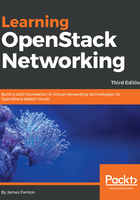
Using a dedicated network node
A network node is dedicated to handling most or all the OpenStack networking services, including the L3 agent, DHCP agent, metadata agent, and more. The use of a dedicated network node provides additional security and resilience, as the controller node will be at less risk of network and resource saturation. Some Neutron services, such as the L3 and DHCP agents and the Neutron API service, can be scaled out across multiple nodes for redundancy and increased performance, especially when distributed virtual routers are used.
The following diagram demonstrates a network node hosting all OpenStack networking services, including the Neutron L3, DHCP, metadata, and LBaaS agents. The Neutron API service, however, remains installed on the controller node. Three physical interfaces are used where necessary to provide separate control and data planes:

The environment built out in this book will be composed of five hosts, including the following:
- A single controller node running all OpenStack network services and the Linux bridge network agent
- A single compute node running the Nova compute service and the Linux bridge network agent
- Two compute nodes running the Nova compute service and the Open vSwitch network agent
- A single network node running the Open vSwitch network agent and the L3 agent
Not all hosts are required should you choose not to complete the exercises described in the upcoming chapters.